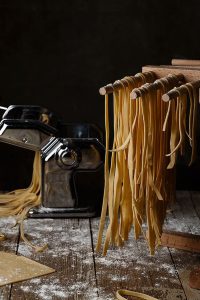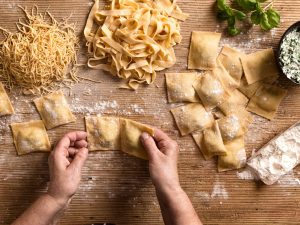Pasta is the staple of Italian Cuisine, and when we talk about the handmade pasta we can think about one word “challenging”, and that can be true, but the real art of handmade pasta is when we taste the real flavor, the freshness, and the tradition that becomes with this simple but flavorful dish.
History of pasta in Italy

The history of pasta had been disputed for centuries, from China and the Middle East to Italy. The popular misconception of pasta arrived in the 13th century in Italy, with Marco Polo, a Venetian explorer, but the iconic dish was part of the Italian diet already.
Food historians state that the pasta scene began around the middle centuries, and it was around that time that our current favorite dishes, such as gnocchi, ravioli and macaroni, began to be created. Although other historians like to think that the Italian fondness for this delicious dish started even earlier, in the 4th century, just before the arrival of the Romans.
After that, during the 14th-century pasta started to romanticize and immortalized by many famous artists, like Goethe or Boccacio, to become later, a dish of the aristocracy. A banquet made for queens, kings, and noblemen, mixing flavors, combining sweet, savory, and spicy.
By the 17th century, pasta turn an unexpected turn started to use industrial processes with the use of mechanical presses and became the staple of Italian food and part of the Italian family traditions, that we can now enjoy in the comfort of our homes or in a restaurant in company.
A personal touch
The art of handmade pasta is more than just a technique and a mix of ingredients, it is about a tradition passed from generation to generation all around Italian families, and now is a dish that we can find and enjoy all around the world.
It is a simple dish full of history and tradition, and here we will explain how to make it artisan, where you only need three ingredients, eggs, flour and salt. And this is where the magic happens when it comes to kneading the flour, beating the eggs, working the dough, and the best part, rolling the dough, where you will be part of choosing the shape you want to enjoy, after all that time and effort, don’t forget the sauce you will accompany it with.
The beauty of handmade pasta and cooking lies not in the complexity of the dish, but in the quality of the ingredients. If this sounded like too much work, head over to Ragazzi and enjoy this traditional dish.

Buon appetito!






